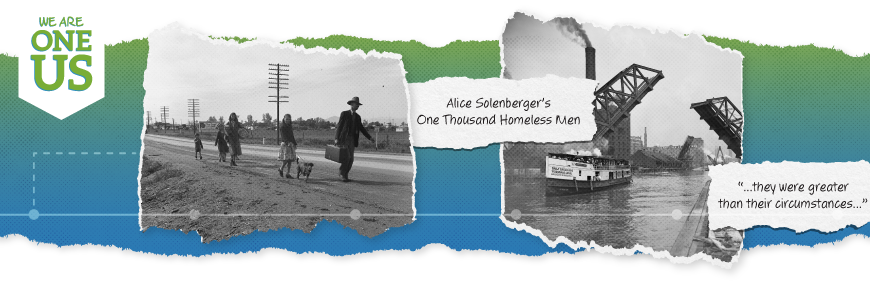Understanding the Realities of Homelessness

How An Early 20th Century Researcher Discovered the Root Causes of Homelessness
Alice Solenberger saw the sides of city life that few wanted to acknowledge. But all she wanted was to learn more.
In 1900, Alice worked for the Chicago Bureau of Charities. Chicago was growing exponentially, and some newcomers were struggling to find work in the bustling railyards and factories. Those who were unemployed and wandering the city often wound up in Alice’s office in search of assistance.
Alice was intrigued by the stories of Chicago’s homeless residents—they were mostly young men who came to the city to find work but couldn’t manage to get jobs for a variety of reasons.
Through the industrial revolution of the late 19th and early 20th centuries, people flocked to cities for the first time in American history. City housing and jobs couldn’t always keep up with the population, however, and homelessness as we know it today began to take shape.
Harmful stereotypes of homelessness also started to appear at this time. People had little interest in understanding the plight of the homeless and quickly dismissed those in need as “bums” or “tramps.” They had no way of knowing why people struggled to pull themselves out of The Churn, because no one had ever really studied homelessness.
And Alice didn’t set out to study homelessness. She simply conversed with the men who stopped by the Chicago Bureau of Charities and found herself fascinated by their stories. Over time, she began to notice similarities and patterns among them—and she got an idea.
For the next 10 years, Alice dedicated her time to interviewing as many homeless individuals as she possibly could. Her interactions with the men showed her they were greater than their circumstances, and she wanted to prove homelessness was more complex than a lack of housing or employment. Through her research, Alice learned what factors lead to homelessness and helped deepen public awareness and empathy for those in need.
Alice’s interviews with 1,000 homeless men created an unprecedented archive of demographic data on the homeless community. She identified several common reasons for homelessness. And while some of her designations and writings are antiquated today, analyzing the causes of homelessness was a new concept in her time.
The common categories of homeless individuals Alice identified included: the crippled and maimed, those injured by industrial accidents, the mentally ill, the epileptic, the elderly, seasonal laborers, chronic beggars and runaway boys.
Alice considered the unique, difficult circumstances of each person while noticing the greater societal issues contributing to their homelessness. She saw the root causes of homelessness and brought them to light.
To better convey the realities of homelessness, Alice combined her data and findings with raw, honest anecdotes from her interviewees.
She told the story of one young man who came to Chicago for work but was left injured from an accident: “A man on his way to newly found and much-needed work one day gave an expressman a lift in handling a heavy trunk. By some awkwardness it slipped and crushed his right thumb. A trifling accident, perhaps, but the sore thumb, although given the best of surgical care from the beginning, not merely lost the man the permanent job to which he was going when the accident occurred, but kept him from any other work for several weeks.”
He, among many of the other men Alice interviewed, fell into homelessness temporarily and became stuck in The Churn. Alice knew that if she wanted to see anything change, she needed to share the trials of these men. Eventually, Alice gathered enough information to compile the book, “One Thousand Homeless Men.”
Sadly, Alice passed away in 1910, before her work went into print in 1911. She left behind the stories no one was paying attention to, but everyone needed to hear. She proved that homelessness is much more than just the lack of housing. She built a framework for understanding and addressing the root causes of homelessness, which is how Solutions for Change works to solve homelessness today.
It just takes just one caring person to change how our society’s biggest challenges are perceived. Alice’s research is essential in social work to this day, but there is still a lot of progress to make.
In the 110 years since Alice conducted her interviews, homelessness in America has been an ever-evolving and expanding problem compounded by limited research to identify root causes of homelessness.
Today, policies are in place that address only one aspect of the homelessness epidemic. Solutions for Change has extended Alice’s research into root causes for over 20 years by helping equip and empower homeless individuals to rise above their unique circumstances. Like Alice, Solutions recognizes that to solve a problem, we must dig deeper, listen to understand, and treat every individual as valuable and capable.
You can read more about Solution’s for Change innovative approach to end family homelessness at www.solutionsforchange.org
Our next blog in this series will explore the expansion of homelessness through the Great Depression and how the Depression brought the struggles of the homeless out of the shadows and into the public eye.

